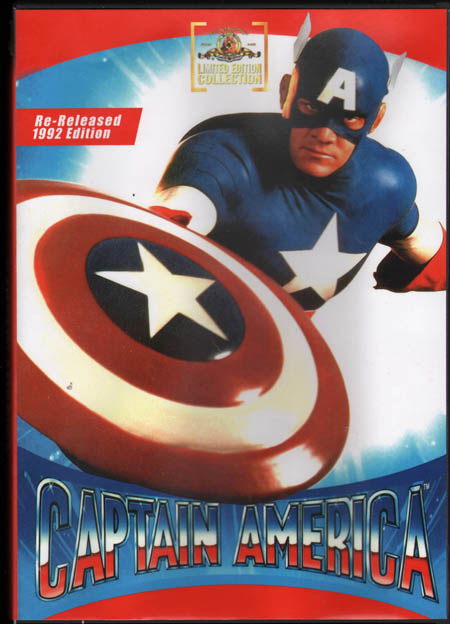
By Lee Pfeiffer
It may seem hard to believe in this day of comic-book inspired blockbusters, but a mere twenty years ago, there was so little interest in adapting comic heroes to the big screen that some of the most legendary pop culture characters were relegated to cheap movies funded by second rung studios. Such was the case with Captain America, shot in 1990 and plagued by problems since the first day of shooting. The film was a production of 21st Century Films, the company owned by legendary schlockmeister Menahem Golan. The movie, which was championed by Marvel's Stan Lee at the time as a wonderful achievement, was originally beset by financial problems. The money dried up, forcing director Albert Pyun to make compromises in terms of special effects and sets. The film was shelved and did not receive a theatrical release in America, although it was seen in the international market.
The movie opens in fascist Italy with a chilling sequence in which a boy genius is forcibly removed from his family, who are then slaughtered in front of his eyes. He is subjected to a cruel and brutal experiment that sees him emerge with extraordinary powers and intelligence, though he is horrendously disfigured. The plan is to produce a master army of such young men to fight for the Axis powers. The person who emerges from the experiment has a twisted mind and is so badly scarred that he is called The Red Skull (Scott Paulin). However, the scientist who designed the formula for the experiment disdains that her achievement will be used for evil purposes. She escapes to America where she offers her talents to the Allies. A polio-stricken young man, Steve Rogers (Matt Salinger) volunteers to be the subject of the first experiment to produce an American super soldier. (The process having been refined to eliminate the disfigurement of the patient.) The plan works and Rogers emerges, not only having been cured of polio, but possessing uncanny strength. However, a Nazi sympathizer kills his mentor, leaving him to be the only living example of the Allies' super soldier. He is given a virtually indestructible costume and a shield with boomerang capabilities. He's also named Captain America (the US never misses a beat when it comes to marketing.) On his one and only war time mission, Captain America succeeds in preventing a German rocket from hitting the White House, but he ends up crash landing in the Alaskan wilderness where he is frozen in ice for decades. A team of scientists accidentally discovers him in 1990 and he is immediately sought by the U.S. government to resume his battle with the Red Skull, whose physical appearance has now been altered to allow him to pass as an influential tycoon. The Red Skull has corrupt corporate bigwigs on his side, along with a high ranking American general.
Although this pre-blockbuster version of Captain America is routinely knocked by Marvel fans, there is much to recommend in this modestly-budgeted adventure film. For one, the casting of Matt Salinger as Steve Rogers is good choice. Salinger, who never gained major stardom, gives a fine performance as the titular hero, maintaining a sense of wonderment at his new powers. Some of the film's best scenes find him trying to adjust to life in 1990, having been under ice since the 1940s. He knows nothing about the great historic figures and events of those missing years and is understandably dazed and confused by modern life (and he doesn't even have to cope with such future inventions as PCs and cell phones). Unsure of who is friend or foe, he avoids everyone as he tries to make his way back to his long-lost finance. In a poignant sequence, he reunites with her, but the obvious age differences (and the fact she is happily married) dooms their chances of resuming their love affair. Fortunately, his ex has a hip, sexy daughter (Kim Gillingham, who plays both mother and daughter) who willingly joins him on his eventual quest to find and defeat the Red Skull, who is lodged in an ancient Italian castle surrounded by his own sexy (but murderous) daughter and an army of henchmen.
The film is uneven throughout and the finale is rather lamely staged, with Captain America joined by his new girlfriend and the President of the United States, who is being held captive in the castle. Most improbably, both of these new allies are almost equally adept at street fighting as the super hero himself. There are far too many blandly staged chase sequences and the villains, aside from a fine performance by Scott Paulin as the Red Skull, are just cardboard characters with no interesting personality traits. Still, director Albert Pyun does a lot with very little and the final sequences in Croatia lend a bit of much-needed exoticism to the proceedings. The film features real life old buddies and Deliverance co-stars Ronny Cox (very funny as the hip U.S. President) and Ned Beatty, but sadly no one thought to write a scene for them to appear in together.
The master print for this DVD is disappointing and is rumored to be the same transfer used ages ago for a laser disc release. MGM does state at the beginning of every DVD that the transfers are made from the best source materials available. Given the current craze for Marvel heroes, they should consider investing in a major overhaul of this title. Director Pyun has stated over the years that his original director's cut of the movie is far superior than the butchered version seen by the public. A Blu-ray, extended version is supposedly in the works.
Captain America is available through most major on-line DVD retailers.